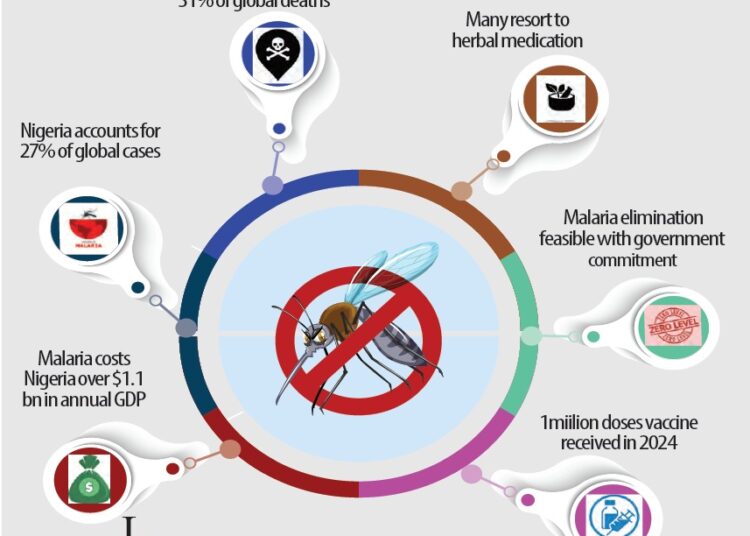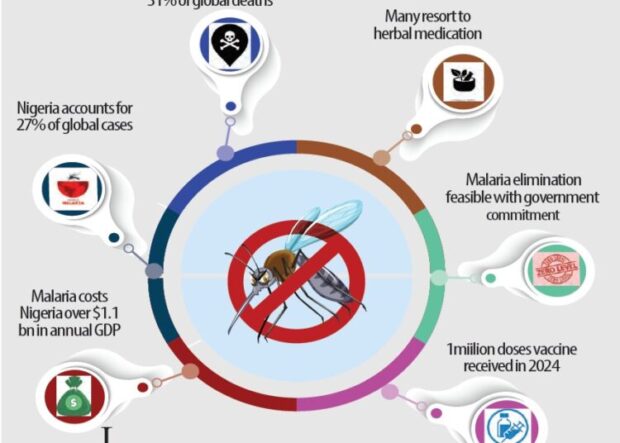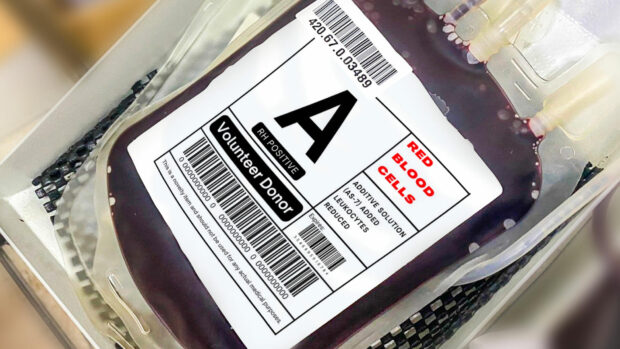
Nigeria’s Staggering N1.156 Trillion Malaria Burden
As the world marks World Malaria Day 2025 under the theme “Malaria Ends With Us: Reinvest, Reimagine, Reignite,” Nigerian families are still grappling with the devastating financial and health impacts of malaria. Despite being both preventable and curable, malaria remains a leading public health challenge in Nigeria, costing families an estimated N1.156 trillion annually in treatment costs.
According to the World Health Organisation (WHO) ’s 2022 report, Nigeria recorded approximately 68 million malaria cases and 194,000 deaths in 2021 alone. This staggering figure makes Nigeria the country with the highest malaria burden globally, accounting for nearly 27% of all cases worldwide .
The Cost of Treating Malaria in Nigeria
Investigations by LEADERSHIP revealed that treating a single case of uncomplicated malaria in public hospitals—covering consultation, diagnosis, and medication—costs about N17,000 . With 68 million cases reported annually, this amounts to roughly N1.156 trillion spent on malaria treatment nationwide. However, the actual figure is likely much higher, as complicated cases can cost up to three times more than uncomplicated ones.
For many Nigerian families, these costs are unsustainable, especially in underserved communities where access to healthcare is limited. Many resort to cheaper alternatives like traditional remedies or over-the-counter drugs, which often delay proper treatment and worsen outcomes.
Malaria: A Persistent Public Health Crisis
Despite significant progress in prevention and treatment strategies, malaria continues to take a heavy toll on Nigeria’s most vulnerable populations—children under five and pregnant women. The disease not only affects health but also has severe economic implications, draining productivity and deepening poverty.
The Minister of Health and Social Welfare , Prof. Ali Pate, described malaria as a “wicked problem” that undermines Nigeria’s health and economic progress. He highlighted the annual loss of over $1.1 billion in GDP due to malaria-related absenteeism, reduced productivity, and increased out-of-pocket healthcare costs.
Calls for Increased Investment and Political Will
Health sector stakeholders have emphasized the urgent need for increased investment and political commitment to eliminate malaria. The president of the Nigerian Association of Resident Doctors (NARD) , Dr. Osundara Tope Zenith, stressed that stronger government funding and sustained efforts are critical to overcoming the malaria burden.
“Malaria is endemic in this country. The burden is enormous, and while we have made progress in handling treatment, eliminating malaria will require much more,” Dr. Zenith said.
He pointed out multiple factors influencing malaria transmission, including rainfall, climate conditions, poor sanitation, and environmental factors like stagnant water and overgrown vegetation. Growing resistance to antimalarial drugs and insecticides further complicates the fight.
A Multifaceted Approach to Elimination
Experts agree that eliminating malaria is possible but requires a multifaceted approach. Key recommendations include:
- Increased Domestic Funding: Reducing reliance on international donors like the World Bank, African Development Bank, and Global Fund.
- Improved Public Awareness: Educating communities on prevention strategies, including environmental sanitation and the use of insecticide-treated nets.
- Development of New Treatments: Continuous innovation in antimalarial drugs and insecticides to combat growing resistance.
- Universal Health Coverage: Strengthening primary healthcare systems and health insurance schemes to ensure affordable and accessible treatment for all.
Dr. Mary Alex-Wele, a senior lecturer and head of medical microbiology and parasitology at the University of Port Harcourt Teaching Hospital, underscored the importance of environmental cleanliness in reducing malaria transmission.
“Certain environments encourage the breeding of mosquitoes, like dirty surroundings, bushy areas, and stagnant water. If we address these issues, we can reduce the burden of mosquitoes around us,” she explained.
The Grim Reality in Underserved Communities
In densely populated slums like Jikwoyi in the Federal Capital Territory (FCT), the harsh reality of malaria’s impact is evident. Families live in squalid conditions, surrounded by stagnant water, refuse, and broken sewage systems.
One resident, Mama Ozioma , shared her struggles: “Malaria is constant in this place. My children fall sick often, and I can’t afford treatment anymore. Drugs that used to cost N500 now cost N1,500.”
Many residents rely on traditional remedies like herbal concoctions because they cannot afford modern healthcare. Even when mosquito nets are available, challenges like overcrowding and misuse limit their effectiveness.
Government’s Role in the Fight Against Malaria
In 2024, the federal government launched the Advisory on Malaria Elimination in Nigeria (AMEN) to drive coordinated action against the disease. As part of this initiative, Nigeria received one million doses of the malaria vaccine, targeting children in high-burden states like Kebbi and Bayelsa.
The National Primary Health Care Development Agency (NPHCDA) vaccinated 101,158 children in these states, integrating the vaccine into existing immunization schedules. However, supply constraints and logistical challenges remain obstacles to scaling up the program.
Call to Action (CTA)
World Malaria Day 2025 serves as a reminder that ending malaria requires collective action. Governments, communities, and individuals must work together to reinvest, reimagine, and reignite the fight against this deadly disease.
👉 Subscribe Now | Follow Us | Share This Story













Be the first to leave a comment